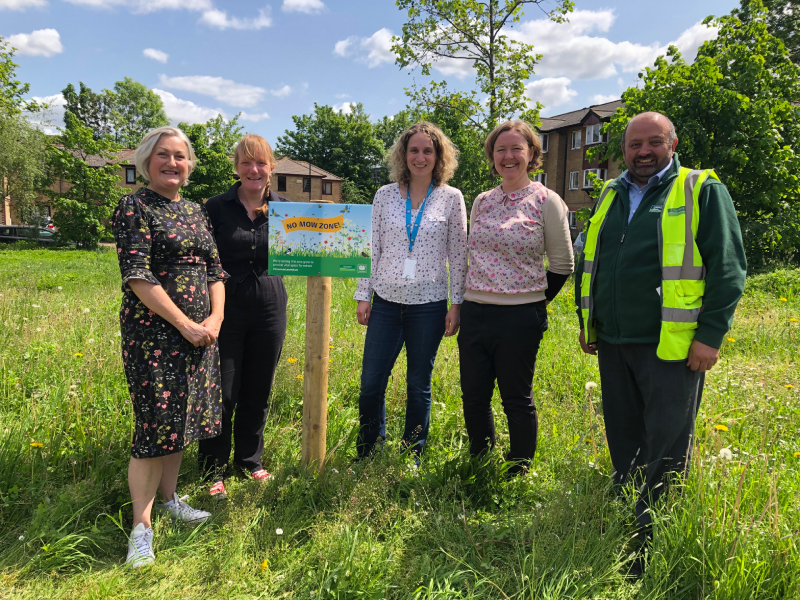No mow zones
Since the 1930s, 97% of UK's wildflower meadows have been lost or changed, leading to the threat of extinction for 87 wildflower species. This habitat loss has also resulted in declines in populations of pollinating insects.
Across the borough, working with our parks contractors, Glendale, we're trialling a new management system regime for grass verges that are nature-friendly with the aim of boosting biodiversity in the area. In late summer, these 'no mow zones', nature-friendly verges will receive one annual cut and then be left to grow throughout the rest of the year. This allows plants to set seed before the cut. The cuttings will be removed to decrease nutrient levels of the soil which helps wildflowers, and create more diverse verges whilst providing feed for the bees, butterflies and other pollinators.
Grass verges can act as wildlife corridors connecting habitats and greenspaces. They not only increase floral diversity but also provide more pollinator habitats, benefiting bees, butterflies, and other invertebrates. We aim to enhance biodiversity in the borough by allowing the verges to grow.
The trial began in May 2023 and will last for 2 growing seasons. Afterwards, we will review its impact. We opted for this trial period since it's probable that the wildflowers in the verges will take this duration to establish.
Verges included in the scheme:
- Bell Green raised grass area (SE26)
- Bentfield Gardens/Stofield (SE)
- Brookmill Road (SE8)
- Downham toilets (BR1)
- Friendly Street grass verges (SE8)
- Grinstead Road verge (SE8)
- Meadowview Road (SE6)
- Pagnell Street (SE14)
- Romborough Gardens (SE13)
- St. Norbert Green (SE4)
- Sydenham Hill (SE26)
- Sydenham Road / Southend Lane (SE26)
- Thomas Lane (SE6)
- Westwood Hill (SE26)
- Whitefoot Terrace (BR1)
- Winchfield Road (SE26)
- Woodpecker Road (SE28)
What can I do to help?
You could take part in No Mow May, a national campaign to encourage people not to mow their lawns until the end of May to boost the flowers, and nectar, available to pollinating insects such as bees, butterflies, and moths.
There are several other things that you can do to help wildlife in your garden. You can find out more about these on our biodiversity page.
Road verge case studies and useful links
Beer Road, Seaton – Management Plan. Produced by the Axe Vale and District Conservation Society, 2015.
Tarka County Trust’s ‘Life on the Verge’ HLF project within the North Devon Biosphere, began in November 2016 and has helped local communities to manage verges for wildlife. This project has produced a step-by-step guide on how to how to get started with your community group and what to do when to get road verges into management for wildlife.
Plantlife verge guidance: The conservation organisation Plantlife has produced a ‘Managing grassland road verges - a best practice guide’ which sets out management principles for road verges.

FAQs
Why has Lewisham Council decided to go ahead with this trial?
We're working to boost biodiversity in our borough by creating nature-friendly verges, as 97% of the UK's wildflower meadows have been lost or altered since the 1930s. By changing the management on these areas, we will help a more diverse range of wildflowers to establish.
This initiative builds on other actions that we are taking to support biodiversity, such as the butterfly scrapes in areas like Beckenham Place Park and creating tiny forests in Ladywell Fields.
How long will it take for wildflower to establish on the verges?
The trial will last for 2 years, and we anticipate that this duration will be enough time for the wildflowers to establish themselves. The timeline may vary based on factors, such as soil type, canopy cover, pollution, and nutrient levels. However, we are optimistic that most of the verges will experience an increase in the number of wildflower species by the end of the trial.
I am concerned that these verges will act as litter traps. How will you manage this?
Litter picking and the cutting of the marginal areas will continue as normal.
What monitoring of the verges will you do during the trial?
Surveys to establish baseline data have already taken place at the sites and we will repeat these surveys throughout the trial period.